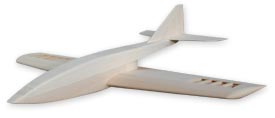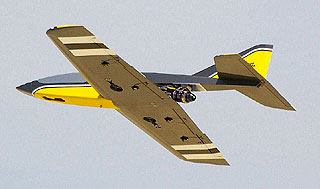|
Hey Isaac, I Got Your Third Law Right Here, Baby!
Laws of nature are cool, especially when they're used for something important like thrust, lift, and
acceleration! Our friend Newton managed to take the incredibly complex and explain it in simple terms.
The same can be done for model turbine engines which are technically very complex, but conceptually very
simple. At its core, a turbine engine takes in air, adds energy, and expels the air creating thrust.
That's the action, which leads us to the equally exciting Reaction.
Model turbine engines are revolutionizing the hobby. Skilled modelers are always looking for a new
challenge and model jets represent the pinnacle of recreational R/C modeling. But it can be a big
jump from a prop-driven aerobatic model to a 200 mph, heavy-metal scale jet with sequenced landing gear
doors, conformal Kevlar fuel tanks, and composite bypasses. The Reaction 54 is meant to be your stepping
stone into the exciting world of turbine models.
About the Reaction 54 Design
A lot of thought went into the design of this model. Listed here are some of the major design considerations
for the Reaction 54.

All Wood - I'm comfortable with traditional wood design, and I figure so are a lot of potential modelers
looking to get into jets. Besides, being all-wood helps it stand out in the jet market that is dominated
by composite designs. You won't find any die-crunched or laser-burned parts in BTE kits. All the wood parts
are machine-sanded to final shape using aluminum templates for accuracy.
Big and Light - Big models are easy to see, and light models are delightful to fly. Bigness helps keep the
top speed down, and lightness helps keep the landing speed down. A big fuselage gives you plenty of room
for all that "stuff" that turbine models need to haul around. A big, thick wing is inherently strong and
gives you plenty of room for retracts. Light weight gives you vertical performance and reduces landing
gear loads.
Retracts - In my opinion, there has been a tendency to make entry-level turbine models too simple.
Aspiring turbine pilots have above-average skills and don't need to step back to a basic trainer.
Retracts are part of the jet scene, and the R54 just wouldn't look right without them.
Exposed Engine - I saved my pennies for several years to buy my first turbine engine, and didn't want
to bury it inside an airframe. Besides, an exposed engine is easy to work on and saves the weight, cost,
and complexity of an exhuast tube, inlets, and bypass. The R54 features an elegant streamlined area just
ahead of the engine to help maintain smooth airflow to the turbine inlet. For lack of a better term, I call
this the "boat tail".
Low Cost - By definition, a turbine model will be expensive compared to most R/C models. Besides the
engine itself, the typical turbine model is expected to have custom-made composite fuel tanks,
spring-loaded landing gear struts, and special machined "jet" wheels. A major goal of the R54 was to
keep the total cost low compared to other turbine designs by using low-cost, off-the-shelf hardware
items like a Du-Bro fuel tank, wire struts, and regular wheels. The R54 blurs the line between your
everyday sport model and what has become the norm in the turbine community.
Safety - The greatest safety feature of the R54 is that it's fairly slow by turbine standards and easy
to fly. Care was taken in the design to protect the fuel tank area from the turbine with a robust
structure in the boat tail. A neoprene pad is provided to cushion the front of the tank in an impact.
The BTE prototype model has been thoroughly flight tested and has proven itself to be a rugged,
well-behaved design that does what it is supposed to do, and does it well.
Things You Don't Normally See on Turbine Models
There are some design and equipment aspects of the R54 that you don't normally see on the "typical"
turbine model. To put your mind at ease, here is the reasoning behind some of my choices made during
the development of the R54.
Push/Pull Cable Linkage for Rudder and Elevator - This might be the most unusual aspect of the
design, but it has proven itself in flight testing and on several of my earlier pulsejet designs.
When installed as shown on the plans, you will find the system makes for a very rigid, slop-free
connection to the control surfaces. The servos are mounted up front to keep the weight forward and
are easy to access under the large hatch.
Easy Hinges - I love these hinges! They are economical and easy to install. Some might question
their strength, but that is addressed by using lots of them spaced fairly close together. If you
go with plastic film, you don't even have to worry about hinging until the model is completely covered.
Wire Landing Gear Struts - These aren't included in the kit, but they are supplied with the
recommended retract package. The struts on the R54 are short, so 3/16" wire is plenty stiff to handle
the loads, even on grass. The R54 lands slow, so it doesn't need the cushioning of more expensive
oleo-style spring struts.
Sport Wheels - A low-speed model like this doesn't need special, high-priced "jet" wheels.
The 3" diameter Sullivan and Hangar 9 sport wheels that I use handle rough terrain with no problem
and the tires have never rolled off the rim even after some bad landings with high side loads.
And they are cheap to replace if necessary.
Electric Nose Wheel Brake - AMA requires brakes on turbine models. Again, considering the
low-speed nature of the R54, brakes aren't really necessary. The Kavan electro-mechanical brake
meets the AMA requirement, is inexpensive, is easy to install, and adds a little weight to the nose
which you need anyway.
Bolt-On Wing - Modelers who have built my designs in the past know that I like to keep things simple.
That's why the R54 has a simple one-piece wing that bolts on like a normal sport model. This provides
a solid center wing joint without the complexity and cost of wing joiners. Besides, the finished wing
is shorter than the fuselage, so transporting is a non-issue.
Open Rib Bays - To drive home the sport model "feel" of this design, I went with some open rib
bays near the tips. I've seen film used on open structures on birds much faster than the R54.
You can sheet the whole wing if you wish (plenty of wood is provided in the kit), but in my
opinion it's just extra weight.
Plastic Film Covering - Okay, this isn't totally uncommon on sport jets. Still, the R54 was
designed with plastic film covering in mind from the outset. Use a high-quality film like Monokote
or Ultracoat.
Flying the Reaction 54
It is hard to describe the feeling you get, standing at the edge of the runway, listening to your turbine
spool up and watching your jet begin to accelerate for its maiden flight. I won't try. For many builders,
the R54 will be their first experience with a turbine. All I can say is take it all in because it's a
feeling you won't forget for a long, long time.

When you transition from prop planes to turbines, the most noticeable difference is the turbine throttle lag.
It will take some time to get used to this, but the forgiving nature of the R54 will help you get through this
learning curve without difficulty. Due to the relative high speed of turbine models and the throttle lag, jet
pilots need to be constantly thinking ahead, particularly during the landing approach. When flying a jet, you
must decide early if you need to go around and do it without hesitation.
There is really nothing tricky about flying the R54. Takeoffs
on pavement typically use up about 150 ft. of runway. Grass runways will obviously require more distance.
The R54 climbs out briskly. Most of your level flying will be done with the throttle
at about 2/3 or 3/4 and the model cruising around at something less than 100 mph. When you are ready to
wring her out, you will find the R54 excels at smooth, jet-style aerobatics.
The rudder is too small for snaps or spins, but it is adequate to hold a knife edge clear across the horizon.
The R54 is designed for aerobatics, not speed.
Landings are slow and easy with the R54. The only time I've gotten into trouble is when I've tried to force it
down onto the runway. My best advice for landing is to just let the model slow down
at its own pace and settle onto the runway when it's good and ready. Pretty soon your landings will be so nice
that you will begin doing what very few "heavy jet" pilots dare: touch-and-goes! After you land and taxi back,
be sure to get one last whiff of that sweet aroma of jet exhaust before shutting down.
Somehow, I think Sir Isaac would be very impressed with this stunning demonstration of his third law!
<Back To Reaction 54 Page
|



